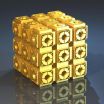(Press-News.org) Researchers at Oak Ridge National Laboratory and Yale University have developed a new concept for use in a high-speed genomic sequencing device that may have the potential to substantially drive down costs.
"The low cost--if it can be achieved--would enable genomic sequencing to be used in everyday clinical practice for medical treatments and preventions," said Predrag Krstic, project director and former ORNL physicist now at the University of Tennessee-ORNL Joint Institute for Computational Sciences.
The research is part of a nearly decade-long drive by the National Human Genome Research Institute of the National Institutes of Health to support the science needed to bring the cost of sequencing a human genome down to $1,000.
ORNL and Yale University researchers have created nanopores, or extremely narrow channels of water, with a radio-frequency electric field capable of trapping segments of DNA and other biomolecules.
In a paper published in the scientific journal Small, titled, "Tunable Aqueous Virtual Micropore," ORNL and Yale University researchers used theory and computation, validated by experiments, to prove that a charged micro or nano particle, such as a DNA segment, can be confined in an "aqueous virtual pore." The water provides a stable environment for DNA integrity while the virtual "walls" allow DNA to move through the nanopore without interacting with physical walls.
As an added advantage, scientists can control the size and stability of a virtual nanopore by external electric fields, something they cannot do with a physical nanopore.
"As a single DNA polymer is translocated through a synthetic nanopore, we use the physical detection of single molecules to read electric signals that identify DNA bases," Krstic said.
To help control and localize DNA, ORNL and Yale scientists created the aqueous nanopore embedded in water based on a linear Paul trap – a device that traps particles in an oscillating electric field – and experimentally proved its trapping functionality.
There were some doubts that a charged micro or nano particle could be confined by the quadrupole oscillating electric field of the Paul trap when filled by aqueous solvent, but ORNL computation and Yale experiments prove that water actually helps stabilize trapping mechanisms, making sequencing methods more feasible.
### Jae Hyun Park, lead author on the paper, worked at ORNL as Krstic's postdoctoral fellow. In addition to Krstic, co-authors on the paper are Yale University's Mark Reed and Weihua Guan.
The research was supported by the National Human Genome Research Institute of the National Institutes of Health and supercomputing hours on Kraken, the National Science Foundation's National Institute for Computational Sciences supercomputer.
ORNL, Yale take steps toward fast, low-cost DNA sequencing device
2012-04-25
ELSE PRESS RELEASES FROM THIS DATE:
Soy-based S-equol supplement reduces hot flash frequency, muscle & joint pain in US women
2012-04-25
Northridge, Calif. (April 24, 2012) – A dose of 10 milligrams (mg) daily of S-equol delivered via a newly developed fermented soy germ-based nutritional supplement is as effective as a standard dose of soy isoflavones at reducing hot flash frequency significantly and is even more effective for relieving muscle and joint pain, according to a peer-reviewed study in US postmenopausal women published in the June Journal of Women's Health, available now as a Fast Track article online ahead of print.
"This study provides evidence that daily doses of the supplement S-equol, ...
Molecule movements that make us think
2012-04-25
VIDEO:
A research group at Linköping University has built five different molecular models of the voltage sensor in an ion channel, which together can explain all the experimental data. The five...
Click here for more information.
Every thought, every movement, every heartbeat is controlled by lightning-quick electrical impulses in the brain, the muscles, and the heart. But too much electrical excitability in the membranes of the cells can cause things like epilepsy and cardiac ...
PNAS: Precise molecular surgery in the plant genome
2012-04-25
This press release is available in German.
The new method is based on the natural repair mechanism of plants. So-called homologous recombination repairs the genome when the genome strands in the cell break. "Using an appropriate enzyme, i.e. molecular scissors, we first make a cut at the right point in the genome and then supply the necessary patch to repair this cut," says Friedrich Fauser from Karlsruhe Institute of Technology, who is the first author of the PNAS publication. "A part of this patch is the new gene piece we want to install. The rest is done by the ...
The search for a job begins and ends with you
2012-04-25
Staying motivated is always tough, but it certainly gets easier when you start seeing results. That's why keeping your spirits up during a job search can be extremely difficult. Candidates often face repeated rejection and rarely receive any feedback. A new study that focuses on finding work following a job layoff reveals just how important managing negative thoughts and effort over time are while looking for employment.
The research shows that having a more positive, motivational outlook had a beneficial effect on job pursuit, especially at the outset of the search. ...
Family history of liver cancer increases risk of developing the disease
2012-04-25
A family history of liver cancer is reported to increase risk of developing hepatocellular carcinomas (HCC), independent of hepatitis according to findings published in the May issue of Hepatology, a journal of the American Association for the Study of Liver Diseases. The study also shows 70-fold elevated risk of HCC in those with liver cancer in the family and markers for hepatitis B (HBV) or hepatitis C (HCV).
Liver cancer ranks sixth in incidence and the third cause of mortality worldwide. According to the World Health Organization (WHO) liver cancer was responsible ...
Fibrosis and fatty liver disease increase risk of early atherosclerosis
2012-04-25
Italian researchers report that severe fibrosis increases the early atherosclerosis risk in patients with genotype 1 chronic hepatitis C virus (HCV) infection. A second study found that fatty liver disease also increases risk of developing atherosclerosis at an earlier period. Both studies appear in the May issue of Hepatology, a journal published by Wiley-Blackwell on behalf of the American Association for the Study of Liver Diseases.
In the first study, researchers led by Dr. Salvatore Petta from the Di.Bi.M.I.S. University of Palermo in Italy evaluated 174 patients ...
Bile – not acid – is bad guy in triggering precancerous condition associated with reflux disease
2012-04-25
For many people with gastroesophageal reflux disease or GERD, acid reflux drugs are the answer to their woes, curbing the chronic heartburn and regurgitation of food or sour liquid characteristic of the disorder. But when it comes to Barrett's esophagus, a condition commonly found in people with GERD, acid control may be less important than beating back another bodily fluid – bile.
A new study published in the Annals of Surgery shows that bile – a digestive fluid that leaks backwards from the stomach into the esophagus along with acid in patients with GERD – plays a ...
Improving on the amazing: Ames Laboratory scientists seek new conductors for metamaterials
2012-04-25
AMES, Iowa -- Scientists at the U.S. Department of Energy's Ames Laboratory have designed a method to evaluate different conductors for use in metamaterial structures, which are engineered to exhibit properties not possible in natural materials. The work was reported this month in Nature Photonics.
Cloaking devices that hide planes from RADAR, microscopes that can see inside a single cell, and miniature antennae that measure only a few millimeters all sound like parts of a science fiction movie. But, within the span of the decade since they began their work, Ames Laboratory ...
Binge eating may lead to addiction-like behaviors
2012-04-25
HERSHEY, Pa. -- A history of binge eating -- consuming large amounts of food in a short period of time -- may make an individual more likely to show other addiction-like behaviors, including substance abuse, according to Penn State College of Medicine researchers. In the short term, this finding may shed light on the factors that promote substance abuse, addiction, and relapse. In the long term, may help clinicians treat individuals suffering from this devastating disease.
"Drug addiction persists as a major problem in the United States," said Patricia Sue Grigson, Ph.D., ...
Yeast cell reaction to Zoloft suggests alternative cause, drug target for depression
2012-04-25
Princeton University researchers have observed a self-degradation response to the antidepressant Zoloft in yeast cells that could help provide new answers to lingering questions among scientists about how antidepressants work, as well as support the idea that depression is not solely linked to the neurotransmitter serotonin.
In findings published in the journal PLoS ONE, researchers based in the lab of Ethan Perlstein, an associate research scholar in Princeton's Lewis-Sigler Institute for Integrative Genomics and senior lecturer in molecular biology, report that sertraline ...


